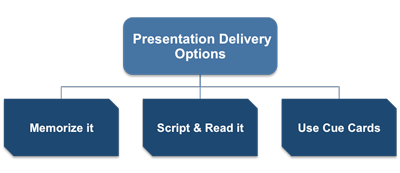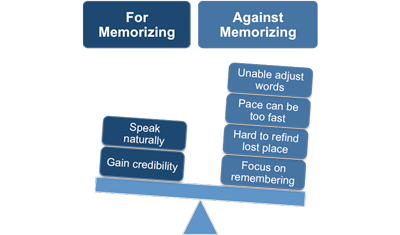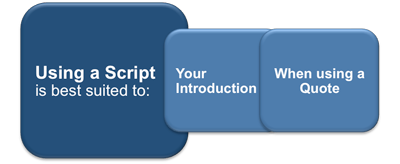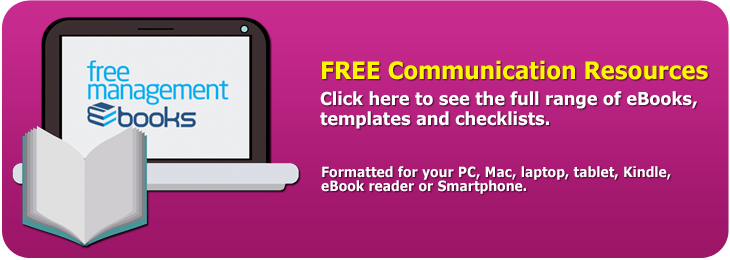Communication Skills - Styles of Presenting
The way that you deliver your presentation has an effect on how engaged your audience will be and consequently how much of your message they take on board. There are three presentation styles that you can use:
- You could memorize the presentation
- You could write a full script and read from it
- You could use free, conversational speech aided by some form of notes or cue cards
 |
Memorizing
Committing a presentation to memory represents an enormous overhead in terms of time and effort and is unnecessary except in situations where you need to present the same thing regularly. Safety briefings and some types of sales presentations fall into this category and if you are someone who finds it easy to memorize a presentation you could find that your credibility benefits from being able to give a smooth delivery of your content with plenty of eye contact.
 |
One drawback of a memorized presentation is that you have to concentrate so hard on remembering what to say that your delivery style can become unnatural. Another is that if you forget where you are in the presentation, the results can be disastrous as you flail around trying to remember the next part. In addition, you will not be able to alter the words you use to match the level of knowledge of the audience.
These factors coupled with the long preparation time involved usually render this technique impractical for most of the presentations that you will give as a manager. However, you may want to memorize the introduction to your presentation as this can give you a minute or so to settle down and get into the flow of speaking to the audience.
Reading a Script
Reading directly from notes is something that should always be avoided as it gives the impression that you are simply a messenger delivering someone else's content. It also makes it look as if you do not know enough about the topic to present it naturally.
 |
However, it is perfectly acceptable to read part of your presentation if it is a quotation from someone else or if it has complex wording or figures. If this is necessary then you should make it clear that you are reading something verbatim and explain the reason for doing so.
Many public speakers use a script read from an autocue. This makes it look as though the presentation is being done from memory, as well as allowing the speaker to focus on the audience. This impression of a lot of eye contact combined with relatively free head movement can facilitate a much more professional delivery than simply reading from a hard copy script.
If you are making your presentation at a conference and an autocue is available, then it may be worthwhile experimenting with it to see if it suits you. If it does, you will need a full rehearsal with the autocue operator who will support you in the actual presentation. You should make sure that they can recognize occasions where you ad lib and pause the machine accordingly.
If you are not experienced in using it, then an autocue can result in a delivery that is dull and fails to engage the audience because it can be difficult to remember that you are there to communicate a message and not just read a script. This is something that can happen when you are presenting to a large audience in a darkened room.
Other disadvantages are the unnaturally fast pace this style of delivery can create and the inability to modify your language to accommodate the audience's understanding of the material - something that may only become apparent as the presentation progresses.
Using Cue Cards
The use of cue cards enables you to employ natural conversational language assisted by pre-prepared cues that hold the main bullet points, notes, and transitions that you need in order to deliver the content of your presentation. With a little practice your delivery will sound normal, natural, and spontaneous, creating a less formal and more relaxed relationship between you and your audience.
The size of a cue card comes down to the personal preference of the presenter - some like 'index' cards, others prefer A5 or A6. They are so widely used that it is usually acceptable for the presenter to hold them in one hand and refer to them openly, as required.
At this stage of your preparation you should have your key message statement, a series of key points, and the detailed script that you need to present. These need to be converted into a series of cue cards that contain sufficient detail to allow you to deliver a spontaneous-sounding presentation.
Cue cards should only hold the level of information necessary to prompt you as to what to say next. This enables you to present in a natural and seemingly spontaneous way. The amount of detail you require will depend upon the nature and complexity of the material you are presenting, your level of familiarity with it, and your experience and confidence as a presenter.
When planning your presentation consider how it will sound to your audience and where you should break for the audience to take a point on board or in order to emphasize what you have just said.
Add these pauses to your cue card by writing 'pause' at the appropriate place. A pause within a presentation should last longer than a break in normal speech - it should typically be between two and three seconds. You will be able to review the effect of this technique in the rehearsal phase and adjust it accordingly.
Another benefit of using cue cards is that if you use one card per key point then changing cards can remind you to make an explicit transition between them. These transitions are an important part of any successful presentation and are explained in detail in the other presentation eBooks available from this website.
The type of phrases you can use as transitions are:
'As I've just explained… (summarize). This brings us on to the next point … (introduce)' (Between key points)
The reason for explicit transitions is that they enable individuals to follow the logic of your presentation even if they have gotten lost during some of the detailed parts. Your transitions offer the audience a chance to 'replay' what you've just told them and help them understand the points you are making.
You may also be interested in:
Giving a Management Presentation | Cue Card Guidelines | Developing a Persuasive Delivery Style | How to Rehearse | Reading Your Audience | Retaining Control in a Presentation | Question and Answer Session | Importance of the Presentation Venue | Presentation Venue Layout.



